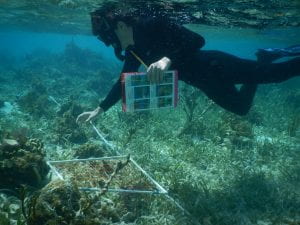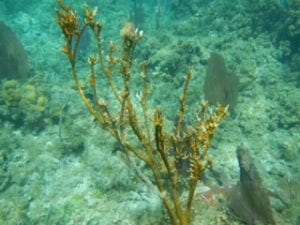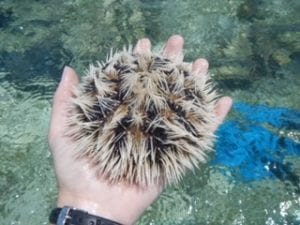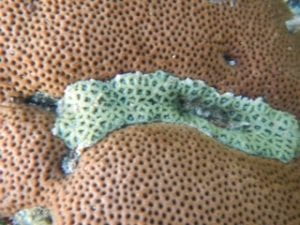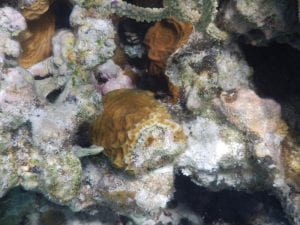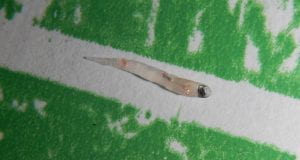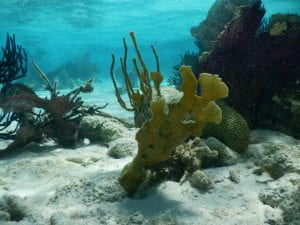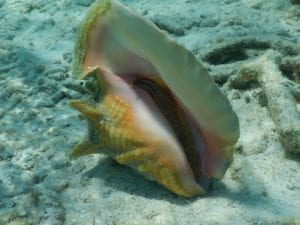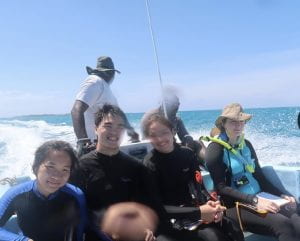Tag Archives: Fire Coral
Fire and Burns
Hey guys! It’s Michiel again : )
We started this morning with breakfast (big surprise) before going out to collect more data for the research question we started on yesterday. The first reef we went to was in the Marine Protected Area, and it was deeper than the reef we went to yesterday. It also had a lot of sea grass, algae, and dead coral. Ava and I laid out our transects and quadrats and counted a lot of coral all over the reef. While we were doing this, Ava took a picture of me counting squares in my quadrat, and I’m sharing it here (once again, thank you Ava)! After collecting this data, we were sent out to collect sea urchins. I found a lot in coral crevices, but these were really difficult to pull off of the coral. However, that did not deter me from trying. I ended up getting two sea urchins, but as I tried to get another one, the crevice my hand was in had fire coral. Thankfully, only my pinky brushed up against it, but I definitely had a burning sensation there for about an hour. It was worth it, though, because we ended up collecting 52 sea urchins! Additionally, I believe I saw a male Bluelip Parrotfish (Cryptotomus roseus), and I definitely saw more Ocean Surgeonfish (Acanthurus bahianus) and Blue Chromis (Chromis cyanea). Scott also took a video with a damselfish in it that kept making its signature popping sound to show aggression. Damselfish are aggressive toward other fish that come near their algal gardens because they don’t want those fish to eat the algae they’ve worked so hard to cultivate.
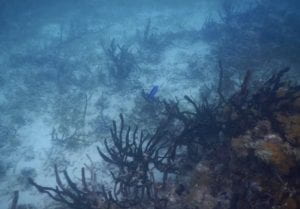
After this, we went to another reef in the Marine Protected Area. This reef was much shallower than the other one; it was about as shallow as the reef we went to yesterday. We did manage to collect our data better in this reef than the one from yesterday, though, because the waves were not nearly as strong as yesterday’s. However, Ava and I were very scared we would touch some fire sponge because it was absolutely all over the reef and we were swimming only inches above it. After collecting our data, we were out on the hunt for sea urchins once again. I collected two sea urchins again, but I learned my mistake from last time and only tried to collect them from beneath coral rubble instead of from inside coral crevices. In total, we collected 56 sea urchins from this area!
On our way back to the island, I noticed that I got a sunburn on my hands, so I’m really excited for the tan I’m about to get that starts at my fingers and ends at my wrists. On the island, we had lunch and were given the option to participate in an optional snorkel activity. I opted out of the activity because I was so drained from this morning, but I spent the afternoon working on my field notebook, messaging some friends, and reading my book. I’m very glad I chose to rest.
At the end of the break, we had dinner, were given presentations on the Belize Fisheries Department and the Belize Coast Guard. Overall, today began with lots of work and ended with a well-deserved break. I’m excited to go out onto the reef again tomorrow to collect more data and see more fish!
Fire Coral – What Doesn’t Kill You Makes You Stronger (Reef Day 4)
Today is the day that my hand, neck, and snorkel mask tans are so defined that they are becoming obvious. We started the day fast and strong TFB-style by hopping into a boat to collect more data for our coral/urchin experiment in two different MPA patch reefs.
The first MPA reef we went to had the best conditions for data collection by far for me and Liliana. The depth (5-6 ft) was perfect, the current was light, and the non-outrageous amount of sea fans helped tremendously with the quadrats. However, I did encounter a challenge at this location. When I was floating and writing on my clipboard, I drifted into a !!*FIRE CORAL*!! It brushed against my elbows and forearms and caused a burning sting. It wasn’t unbearable and went away after 30 minutes, but I have learned to always be on the watch for these vengeful creatures.
^ This is the culprit coral 🙁
The second MPA location was a little more shallow, so this made data collection harder, but the urchin collection led to so many cool finds. One of which was a new taxa discovery! When turning river pieces of coral rubble in search of urchins, I found a red beaded anemone! I was so excited to find a new anemone, and I got a picture of it (the urchin next to it was shortly collected).
I also got to hold a West Indian sea egg! This hedgehog of the sea was named Sally, and she was very adorable and spiny.
Later in the day, we went on a swim just for fun on the lagoon side of the reef crest. This was anemone haven! I saw so many Giant Caribbean anemones; sadly, some of them were bleached. On a happier note, I also got a new taxa sighting here! Encrusted on the side of a mound coral, I found a mat zoanthid colony! The tiny polyps (<1cm) were blue/green and curled up into domes when disturbed. Yay zoanthids!
After dinner, we listened to two guest lectures from the Belize Fisheries Department and Belize Coast Guard. I have so much respect for all that is being done to protect and conserve the ocean and its resources.
Today was extremely productive to the point where I am struggling to finish writing this blog. I look forward to going to bed and having my recurring dream (only started a few days ago for some reason) of going snorkeling and turning into a mermaid. Maybe my dream behind-the-scenes is super inspired by mermaid Ruth!
– McKenna
Crab: 1 Liliana: 0
It’s day 2 on Glover’s and our first day in the water! We had a super early (in my opinion) start, everyone woke up around 6:30 and we all geared up and headed to breakfast at 7. After some delicious banana pancakes we got into the water for the first time and went to a patch reef a little ways off. It was a pretty calm swim through a lot of sea grass and then before we knew it we were at the reef! It was incredible and I wish I had photos to add here but I didn’t bring my camera on the first swim, hopefully someone else here will have photos for you to see! We saw so many corals and fish, and such a wide variety of organisms all over the place. Everywhere you looked there was something new to see. We even saw a small lionfish sitting on the reef, which is not ideal for invasive reef species control, but still interesting to see one out in the wild in real life! The first swim was a good one for my taxon group, crustaceans; we saw a Caribbean spiny lobster hiding in a hole underneath some coral, another organism I have been hoping to see in real life. After about an hour in the water we went out for a break and some land prep for tomorrow before lunch. Around this time I was outside with the two kids who had collected a bunch of crabs in coconut shells. They showed me one smaller crab and despite their warnings that he was (understandably) angry, I tried to pick it up to get a better look. Alas, the crab outsmarted me and got a good chunk of my finger in his claw, luckily it didn’t draw blood, just a long scrape and my hurt pride. Clearly my crab catching skills are a little rusty, but there are plenty of other crabs around that are hopefully a little friendlier.
We went back in the water after lunch, but not before a quick jog through the mangroves of death. While dramatic sounding, it’s pretty much a trail through the island that goes along the mangroves, and is absolutely filled with mosquitos, it felt like they were completely covering us until we all sprinted into the water and hid under the surface for them to go away. Once we got through that we shuffled our way through a bunch of sea grass until we got to a sandy area with lots of patch reefs, and we went swimming through looking for behaviors and organisms as part of a scavenger hunt. This area was less protected by the island from waves so we were pushed from side to side and through the reef and pulled around. My handwriting is already terrible, but with the waves pushing my arms and clipboard around I don’t think any of my notes are legible. Unfortunately these waves also pushed me up against the coral, and soon after I swam further away I realized that the part of my hand that had gotten smacked into the coral was turning red, and felt a little like it was burning. I discovered that I had the misfortune of bumping into a fire coral, named that probably because it hurts when you touch it. Coral: 1 Liliana: 0
However at the end of the day we went through our first round of taxon presentations and lectures, and by then my finger didn’t hurt from the crab and my hand wasn’t burning from the coral, and despite all the bug bites, I can’t wait to do it again tomorrow!
Passenger Fish
May 26, 2019
Today we started and completed a whole new experiment. To look at sea urchin community structure (and the indications it may have for herbivory and reef health), we went out and collected sea urchins in a bucket and recorded the species and diameter of each urchin.
During the search, I noticed several new hydroids! I saw what I believe to be a lot of Box Fire Coral (Millipore squarrosa), which is the third and last species of fire coral that I found to be common in the Caribbean.
I also spotted some Kirchenpaueria halecioides, a small hydroid that gets up to about one inch tall (see photo below) in addition to a possible Feather Bush Hydroid (Dentitheca dendritica).
Much later in the day, we got back in the water for a night snorkel. It was fun, but my dive light went out, and we were all way too close to each other – I think we were all paranoid about losing the group. When I got back, I found a tiny little fish inside my swimsuit. It must have somehow made its way into my skintight dive skin and swimsuit, but nothing can surprise me at this point.
Critter Collection
May 24, 2019
Today, we spent the morning collecting data in two coral reef locations. Liz and I used a similar underwater language today to communicate. We were recording points with live coral or sediment, so cupping our hand into a “c” meant live coral and crossing our index and middle fingers meant sediment.
Exploring the reef after our data collection was incredible. I spotted many fire coral, mostly branching fire coral (Millepora alcicornis) but also some blade fire coral (Millipore complanate).
Later, we returned to the sea to scour an area of seagrass for critters that we could bring in to examine more closely – no hydrozoans or jellyfish were found, but we did gather some other amazing finds, including an octopus, two fire worms, a West Indian sea egg urchin, a sun anemone, and many more. My favorite are the conchs because they’re shells are beautiful, and they have strange little eyes on long eyestalks.
I Am Utterly Exhausted
May 22, 2019
Today was a doozy. We had a three hour boat ride to Glover’s Reef this morning. It was a small motor boat speeding across three hours worth of ocean, so it was more like a three hour rollercoaster.
Once we made it to Glover’s, we immediately had a tour of the island, then lunch, and then our first snorkel. We couldn’t stay out for long because the current was strong, but Liz and I made it out to the patch reef, which was beautiful. I’m so excited to go out there again.
Closer to shore, we spotted many upside-down jellyfish (Cassiopeia xamachana) – a scyphozoan from my taxon ID card!!! These jellyfish are particularly interesting because they often rest on the ocean floor upside down with their tentacles in the air such that they look like harmless plants.
We went out again later to a different area of the reef. This area was much more shallow, which made it harder to navigate. This wasn’t ideal because there were many fire coral. I noticed both branching fire coral (Millipore alcicornis) and blade fire coral (Millipore complanate). These hydrozoans are actually not coral at all and can cause a nasty sting with their nematocysts.
25/05/19 The Chummiest of Friends
This morning we completed (you guessed it) more transects! Again, we went out to two patch reefs, one in an MPA, one not. The first patch reef (within an MPA, nicknamed ‘the Aquarium’) contained lots of fire coral hidden in the coral we were attempting to survey. Weaving the transect tape and manipulating the quadrad was especially hard with the stinging fire coral around, especially since the water was so shallow—there was a limited amount of space above the reef through which we could float. At one point, I was floating directly on top of fire coral—a precarious situation. At (what was intended to be) the second site, there were moon jellies floating around, so we decided not to complete our transects there and opted to move to a different non-MPA site for our final transects. The final area that we decided on to be our non-MPA site was full of lionfish (yum! that’s my taxon!) and squid! After completing my transects, I watched Herby spear a lionfish that was hiding deep within the coral. I am excited to eat these lionfish at a later time.
In the afternoon, the class took the boat out to the fore reef, where we saw the reef drop off, sponges, and bigger animals in general, however, many of us (myself included) fell ill and could not properly appreciate the majesty of the reef in our conditions.
Seasickness
We ended the night with lectures on Anthozoa (non-reef building zoanthids, corallimorphs, and anemones), marine mollusks, and threats to coral reefs (of which there are a lot).
Benthos
Today was a day dedicated to the use of a systematic sampling method, utlilizing measuring tapes and a large physical grid. We answered questions like: What proportion of the patch reef contains some portion of live hard coral and what proportion of the seaweed benthos contains some portion of worm sand mounds?
To remind us of the importance of our work, and mostly to educate us on the overarching context of coral reefs, Ceyda Sidd ’19 explained that the percent cover of corals in Belizean waters is 13 – 15% and declining. Tomorrow we will be analyzing the data we collected today on percent cover of live hard corals to estimate the degree of decline in coral cover. One of the things that we have learned about working with corals is that it is in our best interest to not touch them. We saw fire corals, that upon contact can sting, and all corals are sensitive to human touch, such that it can destroy or stop the growth corals. The difficulty is real, though, as many of the patch corals exist in waters less than 3 ft deep, and some areas are too shallow to even swim across without touching some corals. Even conservation workers sometimes will cause harm to the things they wish to conserve; the act of quantifying and observing is sometimes inevitably an act of slight destruction. In snorkeling lingo, we all aim to be horizontal (floating) and not vertical (standing).
In the evening, we laid in hammocks with the company of incroaching lightning storms, which provided us with fantastic views and some rain. If we did end up stranded, which we are 80-95% likely to (someone jokingly said),I think none of us would be too distraught. The days here sucks out your energy, but in the best way possible: in the sun, under the water, above the benthos, and next to marine creatures.

Day 3- I ITCH EVERYWHERE
Day 3, and I have learned that bugs hate me and that fire coral is mean. I think I jinxed myself by saying I did not have any bug bites because now I am covered. Plus I bumped some fire coral so my rear is itchy and hurts, making fire coral my least favorite coral. Pseudodiploria labrinthiformis is easily my favorite though and I have been finding and identifying it!
Back in the world of crabs, I have stopped getting overly excited over land hermit crabs now. I counted 213 of those little guys just today. There is one part of the trail that is just land hermit crabs (184 in one place). They seem to be very spotty on the island as to where they are most found. We tried to quantify their per square meter space on the island using quadrants and a transact, but it resulted in very little crabs and brac holes being recorded when in actuality they are everywhere.

I also saw a mangrove crab today on the pillar of the dock. It was camouflaged above a bunch of algae. A few minutes prior I noticed two unidentified crabs. They were two hermit crabs on a turtle sea grass leaf very close together and moving up the leaf. From their shells I first thought they were mollusks but then I noticed their blue pincers sticking out. I am not sure what type of hermit crab has blue pincers, but they were interesting to watch.
AND OF COURSE, I saw some more blue land crabs at night. They are really much more accustomed to humans than I had imagined they would be. They don’t even run away when walk by or even when I run at them.
Well the benedryl I just took for the fire coral is kicking in and I’m about to sleep for days… well really only like 7 hours but thats alright.





